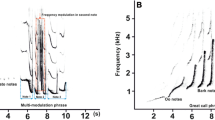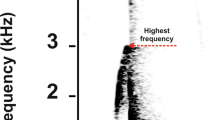Abstract
Gibbons are apes that are well known to produce characteristic species-specific loud calls, referred to as “songs.” Of particular interest is the sex specificity of the “great calls” heard in gibbon songs. However, little is known about the development of such calls. While great calls are given by female gibbons of various ages, they have never been recorded from males. Here, we report two observations of immature male gibbons from two different species, wild Hylobates agilis and captive H. lar, which spontaneously sang female-specific great calls. Based on the video clips, we conclude that immature males also have the potential to produce great calls. Our observations led us to propose a new hypothesis for the development of sexual differentiation in the songs of gibbons, and its implications for the general issue of sex-specific behavior in primates.


Similar content being viewed by others

References
Brockelman WY, Schilling D (1984) Inheritance of stereotyped gibbon calls. Nature 312:634–636
Geissmann T (2002) Duet-splitting and the evolution of gibbon songs. Biolog Rev 77:57–76
Haimoff E (1984) Acoustic and organizational features of gibbon songs. In: Preuschoft H, Chivers D, Brockelman WY, Creel N (eds) The lesser apes: evolutionary and behavioural biology. Edinburgh University Press, Edinburgh
Koda H, Oyakawa C, Nurulkamilah S, Rizaldi, Sugiura H, Bakar A, Masataka N (2012) Male replacement and stability of territorial boundary in a group of agile gibbons (Hylobates agilis agilis) in west Sumatra, Indonesia. Primates 53:327–332
Koda H, Lemasson A, Oyakawa C, Rizaldi, Pamungkas J, Masataka N (2013) Possible role of mother-daughter vocal interactions on the development of species-specific song in gibbons. PLoS One 8:e71432
Lappan S, Whittaker D (2009) The gibbons: new perspectives on small ape socioecology and population biology. Springer, New York
Marshall J, Marshall E (1976) Gibbons and their territorial songs. Science 193:235–237
Marshall J, Sugardjito J (1986) Gibbon systematics. In: Swindler DR, Erwin J (eds) Comparative primate biology, vol 1. Alan R Liss, New York, pp 137–185
Merker B, Cox C (1999) Development of the female great call in Hylobates gabriellae: a case study. Folia Primatol 70:97–106
Oyakawa C, Koda H, Sugiura H (2007) Acoustic features contributing to the individuality of wild agile gibbon (Hylobates agilis agilis) songs. Am J Primatol 69:777–790
Preuschoft H, Chivers D, Brockelman WY, Creel N (1984) The lesser apes: evolutionary and behavioural biology. Edinburgh University Press, Edinburgh
Schilling D (1984) Song bouts and duetting in the concolor gibbon. In: Preuschoft H, Chivers D, Brockelman WY, Creel N (eds) The lesser apes: evolutionary and behavioural biology. Edinburgh University Press, Edinburgh, pp 390–403
Acknowledgments
We thank Akira Kato, Jun Koike, Yuji Takenoshita, Koichiro Zamma, Takahisa Matsusaka, Noriko Ito, and all of the staff of the Japan Monkey Center for permitting us to conduct this study and for their assistance. We are grateful to Syamsuardi, Santi Nurulkamilah, the staff of Andalas University, and many friends in Indonesia for their tremendous support and friendship; and to John C. Mitani and Esther Clarke for their comments on our manuscripts. Our fieldwork was conducted under the Memorandum of Universities between KUPRI and UNAND. This study was supported by a Grant-in-Aid for Overseas Research (B) (20405016) to Hirohisa Hirai (HK joined as a co-PI), and by the Young Researcher Overseas Visits Program for Vitalizing Brain Circulation from the Primate Research Institute, Kyoto University.
Author information
Authors and Affiliations
Corresponding author
Electronic supplementary material
Below is the link to the electronic supplementary material.
10329_2013_390_MOESM1_ESM.wav
Supplementary material 1 The typical example of an immature male gibbon singing great calls in the wild. The sound spectrogram was shown in Figure 1. (WAV 510 kb)
Supplementary material 2 This is the video clip in which we successfully filmed the first case of male great calls in captivity. At the time (11th July, 2008), we were filming gibbon singing for another purpose, so the video camera on the tripod was placed in front of the home cage, covering a wide view of the cage, not focusing on the immature male (Bobby). Bobby had a middle-sized body with black fur. The mother was a large gibbon with a brown and buff fur color, and the smallest gibbon with white fur was her 2-year-old son. The mother’s male partner was not filmed, but his songs were recorded in this video. First, the mother sang the great calls alone. Just after the mother started to sing the great call, Bobby approached her closely. The 2-year-old son also approached her after Bobby. As the mother’s great call reached its climax, Bobby also began to sing. The mother jumped from the branch to right side when singing the climax. Bobby also jumped to the left side while singing, following the mother’s great call and jumping behavior. The 2-year-old son also jumped following the mother and Bobby. (WMV 22213 kb)
Supplementary material 3 This video clip was made after Video S2. After watching Bobby’s great call, we tried to film him at a closer distance. As in S2, the mother first started to sing a great call. As the mother’s great call reached its climax, Bobby also joined in singing. In this case, the mother did not brachiate as much, while Bobby brachiated while singing his climax. Interestingly, the 2-year-old son approached the mother when she singing the climax part, and repeatedly called with very high pitch screaming. At the end of this video, the male partner (black fur) entered the film, but he did not join in the duet at that time. (WMV 20457 kb)
Supplementary material 4 The final observation was made after Video S3. In this case, when the mother started to sing, Bobby almost simultaneously started to sing with her. Bobby remained close to his mother during the early part of the singing. During their singing, the screams of the 2-year-old son were sometimes heard too. At the climax part, only Bobby jumped in the cage. A short conversation in Japanese between the observer (HK) and the keeper is included in the video clip. (WMV 17039 kb)
Supplementary material 5 A sample video clip of an immature male gibbon singing great calls in the wild. The larger gibbon was the mother, and smaller one was her son (Air). The two of them sang together in the canopy of a 20-meter-high tree. At the time of this video clip, the mother had already started to sing great calls, and Air had not previously begun to sing with her. After the mother had sung the great calls several times, Air also sang with her. As the great calls reached a climax, the two of them brachiated through the canopy of the forest. In this video, the mother moved first and was then followed by Air replicating her movements. (M4V 16409 kb)
About this article
Cite this article
Koda, H., Oyakawa, C., Kato, A. et al. Immature male gibbons produce female-specific songs. Primates 55, 13–17 (2014). https://doi.org/10.1007/s10329-013-0390-2
Received:
Accepted:
Published:
Issue Date:
DOI: https://doi.org/10.1007/s10329-013-0390-2



